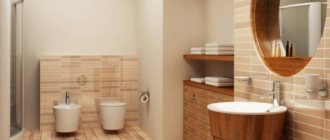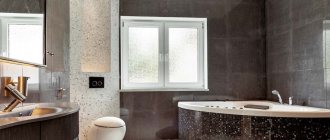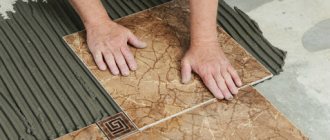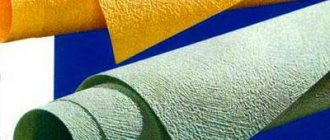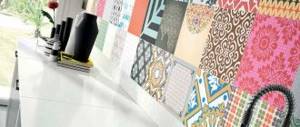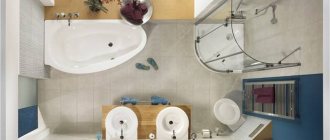Features of the work
Painting bathroom tiles with your own hands is appropriate in the following cases:
- room decoration;
- masking imperfections on the wall;
- change of scenery.
When doing decorative work, patterns or drawings are made on a plain wall. Masking involves covering up chips and cracks in the cladding. If the decoration becomes boring, they change the interior of the bathroom without damaging the tiles.
The painting method has many advantages and disadvantages. Advantages:
- interior renovation occurs without a lot of time and money;
- coating defects are removed;
- the ability to choose color options;
- ease of work.
The disadvantages include the fragility of the applied layer, but the coating can be changed if necessary.
Can tiles be painted?
Can. This unique, durable, moisture-resistant coating can easily be renewed using just this method. At the same time, the ceramic surface is painted very well - the main thing is to choose the right paint and choose the place where it will be applied.
Is it possible to paint tiles on the floor?
On walls, floors and even ceilings, tiles can be safely updated with a fresh coat of paint - there their contact with water will be minimal, and the paint is unlikely to wear off quickly. But it is not recommended to paint tiles located inside showers directly under your feet or directly above the bathtub. The fact is that the durability of the paint and varnish coating, even the highest quality, directly depends on the intensity of exposure to water. And in the shower and above the bathtub, an environment that is too humid for even the highest quality and most reliable paint. In such places, the coating will quickly begin to peel off and all the work will have to be done again. Conclusion - you can safely paint absolutely any tile if it has moderate contact with water.
Painting tiles on a bathroom wall
With the help of paint, the interior of a kitchen or bathroom can be constantly changed as soon as such a desire arises from the owner of the room. Previously, this was exactly how apartment owners got out of the situation; this method of renovating premises was quite common.
On a note! If high-quality paint was used, and all work was carried out strictly according to the rules, then such a coating can last on the tile for up to 30-50 years.
Painting tiles: pros and cons
Tile is a strong and durable decorative covering. It can be glossy or matte. It depends on the texture of the top layer: smooth or slightly rough. Theoretically, anyone can paint it themselves. But the strength of the color may vary. Thus, coloring preparations adhere worst of all to glossy bases. It requires special pre-treatment.
It is important to choose the right composition. Some paints are absolutely not suitable for these purposes. In general, coloring is possible for any type of tile.
Pros of coloring
- Quick interior update.
- Removing visible defects of the old coating.
- Variety of color options.
- Minimum cash investment.
- Easy to do. An inexperienced master can handle the job.
Minuses
The disadvantages of the solution include the fragility of the new coating for some types of paints. True, nothing prevents you from updating it from time to time. Then the result will be better. It is better to paint floor tiles only with epoxy or latex compounds. Otherwise, intensive use will quickly deteriorate the new finish. But painted ceramic wall cladding lasts longer.
Painting can be continuous or selective. In the first case, paint is applied to the entire area of the walls. In the second, only fragments are painted, patterns, panels, etc. are drawn. It is especially good in this case to use a stencil. This way you can zone a room and draw attention to a specific area of it. For decoration, choose only one tone or play with color. Close combinations or contrasts - there are no rules here. Any design the owner likes can be used.
Look at the photo: before and after staining. How the old bathroom was transformed.
Necessary equipment
To prepare and paint tiles and floor tiles you will need:
- metal brush;
- sponge;
- degreasing liquid;
- roller and brush;
- materials for application to walls;
- masking tape;
- palette;
- paper or plastic film;
- Remedies.
It is recommended to use a set of several paint brushes and rollers. They should have different sizes, pile lengths and bristle stiffness. The foam tool paints large surfaces well and quickly. Brushes are used to create drawings. We need flute ones for large surfaces and paneled ones for applying small, thin patterns. Before use, they are soaked in water. The bristles swell and become elastic.
Primers and paints are selected based on their contact with each other. The tape will help you make lines and cover surfaces that you don't want paint to touch. On a palette, the function of which can be performed by a piece of plywood or tile, different shades are mixed to obtain the desired color. The film covers the bathroom floor to prevent drops from getting on it.
Painting tiles requires the use of concentrated paint with rich tones. When the applied layers dry, it is recommended to use the bathroom less often so as not to harm the design.
Preparing tiles for painting
From the very beginning you need to wash the base. The paint is applied in a thin layer and even small irregularities - drops of grease, lime stains - everything will be visible. Therefore, we wash and clean thoroughly. If you decide to paint the floor tiles in the bathroom, first remove all silicones, grout, level and clean the seams.
It all starts boringly - with cleaning
Further. If the tile is glazed, it is better to scratch the glaze. There are many ways.
- If you have a grinding machine, this will simplify the task. We use sandpaper with medium grain and make the surface rough.
- You can try a grinder with a grinding attachment. But it will be too dusty.
- Wire brush.
- A block wrapped in coarse or medium grit sandpaper. We select the grain experimentally.
After sanding, dust should be removed (with a vacuum cleaner). The following describes the processing.
Brushes, scrapers, abrasive and non-abrasive detergents - anything to keep the base clean
Some primers have such good “adhesion” that there is no need to sand a smooth surface (for example, Zinsser Bulls Eye). Then the base should be washed and degreased. For degreasing, you can use White Spirit 1050 or Pensselipesu detergent. Wait for it to dry.
Work on painting tiles begins with preparing the surface and the room itself. To begin with, it is recommended to clear the room of furniture and interior items that may interfere with the work. It is recommended to cover anything that cannot be removed with plastic wrap to prevent drops of paint from falling onto the surface. While the paint on smooth objects can still be wiped off, the upholstery of the upholstered furniture cannot be saved without dry cleaning.
It is advisable to cover the furniture with film
The surface of the tile itself also needs preparation. If you neglect this stage, the layer of paint and varnish material will quickly begin to peel off and crumble. The surface of the tile is first washed with some cleaning agent. If the tiles are painted in the kitchen, then it is important to remove all grease stains - the paint will not stick to them. You can degrease the surface using a special liquid or use vinegar or an alcohol solution.
Washing ceramic tiles
Then, as soon as the tile is dry, it is carefully sanded with sandpaper - it is necessary to make the surface slightly rough. Only in this case will the paint stick well. If the tiles on the floor are rough in themselves, then you can do without the grinding step.
We invite you to read about Simmering dishes - why it’s easier and tastier in a cast iron pot
It is also important to inspect all tiles before painting to make sure they are intact. Damaged elements must either be removed and replaced with new ones, or repaired.
Suitable paint and consumables
The selection of coloring compounds is an important matter when repairing an old coating. When painting ceramic tiles in the bathroom, choose materials that are highly resistant to detergents and water. For a closed room, an epoxy or acrylic solution is suitable. The latter has bright colors and is easy to apply to the surface. Epoxy-based paint is odorless and dries quickly.
When dry, a glossy or matte film remains on the wall. But there is semi-matte enamel, it hides dirt and stains well and gives the tile a velvet look. The best options can be purchased from reputable manufacturers. Inexpensive formulations do not always contain the necessary components, and others can release harmful substances. The correct coating can withstand high humidity and temperature changes. Alkyd enamels cannot cope with these tasks.
Oil paints adhere firmly to tiles. They are distinguished by a long service life and have a rich range of colors. To create the desired shades, oil compositions are mixed with each other. The material applied to the wall takes a long time to dry and smells unpleasant. Over time, the color turns yellow, this is visible on white or light-colored surfaces.
Epoxy enamel forms a durable film on the surface that does not fade and does not react to temperature changes. The paint is fireproof and waterproof. Microorganisms do not multiply on it. The disadvantage is the high cost and some difficulties in operation.
Latex emulsion makes the coating moisture-resistant, resistant to cleaning and washing. The layers have plasticity, so they do not crack. When applied to the surface, the paint can heal cracks up to 1 mm wide. The disadvantage is low light fastness and high cost.
Latex, oil and epoxy compounds are suitable for painting the entire surface. They cannot be used to apply paintings or patterns. It is better to choose stained glass preparations that can be placed on any base without preparation, stay on it for a long time and do not fade.
Compositions for priming work are selected from the manufacturer that produces the paint.
Types of paint and methods of painting bathroom tiles, patterns on tiles and further care
Beautifully laid tiles decorate the room for a long time, but over time you want to update the interior.
Removing old tiles and laying new ones is a labor-intensive, lengthy process that requires financial costs, and it is not always possible to carry it out.
Today, paint for tiles is produced, with the help of which you can quickly and at minimal cost change the design of the room.
You can not limit yourself to painting, but use artistic decoration with thematic drawings, apply patterns with stained glass ceramic compositions.
Those who are not good at drawing can use stencils.
Surface priming
Before painting the walls need to be prepared. The work consists of applying a primer that holds the layers of dye. First, the surface is cleaned of dirt, hard deposits, dust, and traces of mold. The seams between the tiles require attention. Preparation is carried out using solvents, detergents and degreasers, which are applied with a special sponge. During work, chips and cracks, traces of old putty and glue are eliminated.
It is recommended to sand the coating with fine sandpaper. This will ensure the tiles adhere to the paint. After washing, it is necessary to degrease the wall with turpentine, solvent or white spirit and prime it using a tile solution with a brush or roller.
Color options
Painting can be selective (coating fragments or applying patterns) or continuous. You can zone a room to highlight a certain area. This is done using a single tone or color. The reasons for the repair are:
- wear of tiles;
- decorating the environment;
- restoration of the drawing.
The material wears out most often due to the fault of an unreliable manufacturer. Decorative changes are made to the interior of the house using stencils. This method is convenient and makes the room beautiful. Restoration is needed when part of the pattern on the tile is damaged during the removal of furniture or the installation of plumbing equipment. Artists are sometimes involved in the work.
The whole wall is one tone
The surfaces are covered with one tone when the situation in the bathroom changes. It can be a bright color that matches the intended design of the room: green, yellow, orange, pink, etc.
Painting by cells
A special atmosphere is created by painting individual tiles in different colors. A multi-color panel is created in a checkerboard pattern using any number of shades.
Drawings through a stencil
Any design can be applied to the walls. Possible design of marbled tiles, images of sea views, landscapes of tropical countries, animals and birds. The themes depend on the personal preferences of the apartment owners.
The design is often applied using a stencil. It's convenient and fast. You can create small-sized paintings and full-wall compositions.
How to create a panel using paint
An original decoration is an ornament or panel made by an artist. The size of the composition is any. The image of a summer beach, swimming fish and aquatic animals look beautiful. The layers of paint are secured with varnish. It is polished to give it a characteristic shine.
When creating panels, vinyl stickers and stencils are sometimes used. Shades are applied alternately. Brushes need to be washed and changed more often.
You can create an updated interior in your bathroom without much effort. It is enough to paint the surface of the tile with paint of the desired tones or draw a picture.

